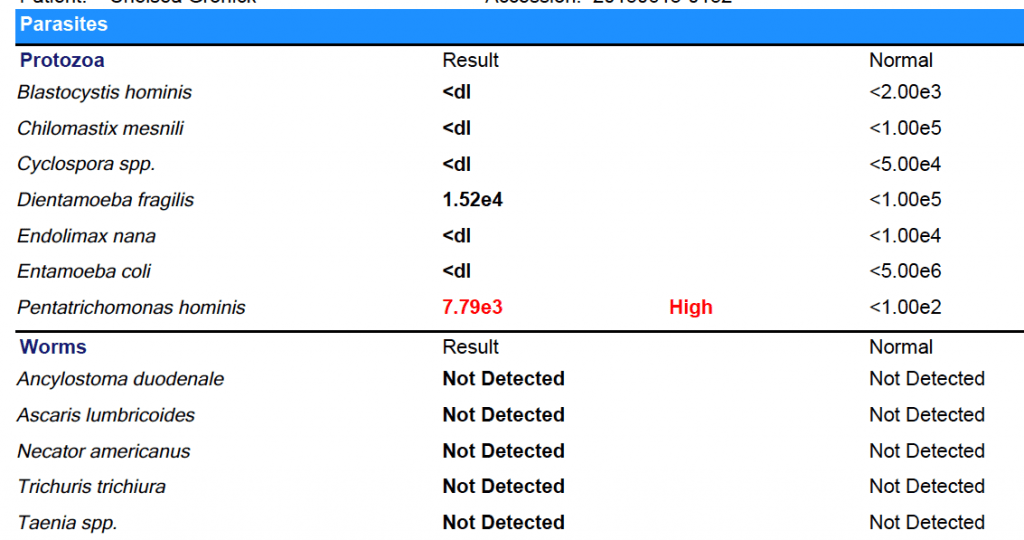GI Map Stool Test
One of the most common tests that I use in my practice to help my patients uncover the hidden causes of their digestive symptoms is the GI Map Stool Test. You can read more about my unique approaches to Digestive Restoration and SIBO.
Chronic GI symptoms, like bloating, gas, abdominal pain and cramps, nausea, constipation, diarrhea; brain fog, leaky gut, allergies, hormonal imbalance, and food sensitivities may trace their origins to imbalanced gut microbes as a root cause.
Even chronic health conditions like autoimmunity, Hashimoto’s hypothyroid, Grave’s, inflammatory arthritis, chronic fatigue, and many other health conditions could have a digestive component that may be uncovered by comprehensive stool testing like the GI Map.
THE GI MAP THOROUGHLY TESTS YOUR GUT MICROBES
Your stool sample is tested for the presence and levels of:
- The common beneficial friendly gut bacteria.
- Commensal bacteria – these are neither friendly nor unfriendly, they are fine when present in small amounts and problematic if overgrown.
- Pathogenic bacteria that cause inflammation.
- Bacteria associated with autoimmune disease.
- Worms
- Parasites – these are microscopic and more common than you may think.
- H Pylori bacteria
- Epstein-Barr virus
- Yeast and fungal organisms such as Candida.
- Leaky gut
- Gluten sensitivity
- Inflammation
THE GI MAP ASSESSES YOUR DIGESTIVE FUNCTION
Besides microbes, the GI Map evaluates:
Your pancreatic enzyme production. If your enzyme production is low, you may see undigested food in your poop.
Fat in your stool. This identifies a problem with fat digestion, which is often a liver or gallbladder issue, as your liver makes bile to emulsify fats, and your gallbladder squirts it out on demand. You can detect liver or gallbladder issues before they become big problems.
Anti-gliadin antibodies. Your immune system makes these when gluten is a problem. Also, for people who are off gluten, the presence of these antibodies indicates that you are reacting to gluten cross-reactive foods. This is important to investigate especially if you have autoimmunity.
Inflammation in your GI tract through a marker called calprotectin. I use this frequently with my autoimmune colitis and Crohn’s patients to monitor how our autoimmune treatment is working.
The immune activity in your GI tract by measuring secretory IgA. This tells you if your gut immune system is underactive, overactive, or working perfectly.
WHO SHOULD TAKE THE GI MAP TEST?
Anyone with digestive symptoms that are unresolved, such as bloating, indigestion, food intolerances, GERD, small intestine bacterial overgrowth (SIBO), IBS, and bowel movements that are not a #4 on the Bristol scoring chart:

This test is also useful for investigating the source of inflammation in other parts of your body, including arthritis, aches and pains, osteoporosis, excessive allergies, sinus inflammation, brain fog, anxiety, depression, and cognitive decline. A functional approach to searching for the source of these inflammatory conditions always includes checking out your digestive function and your microbiome! A disruption in a healthy microbiome is correlated with these conditions.
Lastly, for anyone with an autoimmune disease, it’s useful to do a G.I. map test because healthy gut function and an optimal microbiome are very important to keep autoimmune diseases in remission. Often flares of autoimmunity are triggered by gut issues such as dysbiosis (unfavorable gut microbe populations).
Here’s a quick peek at what a few of the sections on the GI Map stool test look like:



Complete List of Things Measured on the GI-MAP
PATHOGENS
- Bacterial Pathogens
- Campylobacter
- Clostridium difficile, Toxin A
- Clostridium difficile, Toxin B
- E. coli
- Enterotoxigenic E. coli LT
- Enterotoxigenic E. coli ST
- Shiga-like Toxin E. Coli stx1
- Shiga-like Toxin E. Coli stx2
- Shigella
- Salmonella
- Vibrio cholerae
- Yersinia enterocolitica
- Viral Pathogens
- Adenovirus 40/41
- Norovirus GI
- Norovirus GII
- Rotavirus A
- Parasitic Pathogens
- Cryptosporidium
- E. histolytica
- Giardia
H. pylori
- Helicobacter pylori
- Virulence Factor, cagA
- Virulence Factor, vacA
NORMAL BACTERIAL FLORA
- Bacteroides fragilis
- Bifidobacterium spp.
- Enterococcus spp.
- Escherichia spp.
- Lactobacillus spp.
- Akkermansia mucinophila
- Clostridia (class*)
- Faecalibacterium prausnitzii
- Enterobacter spp.
- Clostridia spp.
OPPORTUNISTIC BACTERIA
- Potential Autoimmune Triggers
- Citrobacter freundii
- Klebsiella pneumoniae
- Proteus spp.
- Proteus mirabilis
- Methanobacteriaceae (family)
- Fusobacterium spp.
Additional Dysbiotic/ Overgrowth Bacteria
- Bacillus spp.
- Enterococcus faecalis
- Enterococcus faecium
- Staphylococcus aureus
- Morganella spp.
- Pseudomonas spp.
- Pseudomonas aeruginosa
- Staphylococcus spp.
- Streptococcus spp.
PARASITES
- Blastocystis hominis
- Dientamoeba fragilis
- Endolimax nana
- Entamoeba coli
- Chilomastix mesnelli
- Pentatrichomonas hominis
FUNGI/YEAST
- Candida albicans
- Candida spp
- Geotrichum spp
- Microsporidium spp.
- Trichosporon spp.
- Rhodoturula spp.
OPPORTUNISTIC VIRUSES
- CMV- Cytomegalovirus
- EBV- Epstein Bar Virus
WORMS
- Ascaris lumbricoides (roundworm)
- Nector americanis (hookworm)
- Trichuris trichuria (whipworm)
- Taenia solium/saginata (tapeworm)
- Cyclospora cayetanenensis
ADDITIONAL TESTS
- Secretory IgA
- Anti-gliadin SIgA
- Elastase-1
- Calprotectin
- b-Glucuronidase
- Steatocrit
- Fecal Occult Blood
See a sample report here
If you’ve been looking for answers to your digestive concerns, the GI Map might just be the solution. After a through health and digestive system evaluation, I help to determine if this test would help you to regain health of your digestive system and then use the right treatments to correct the underlying issues.
